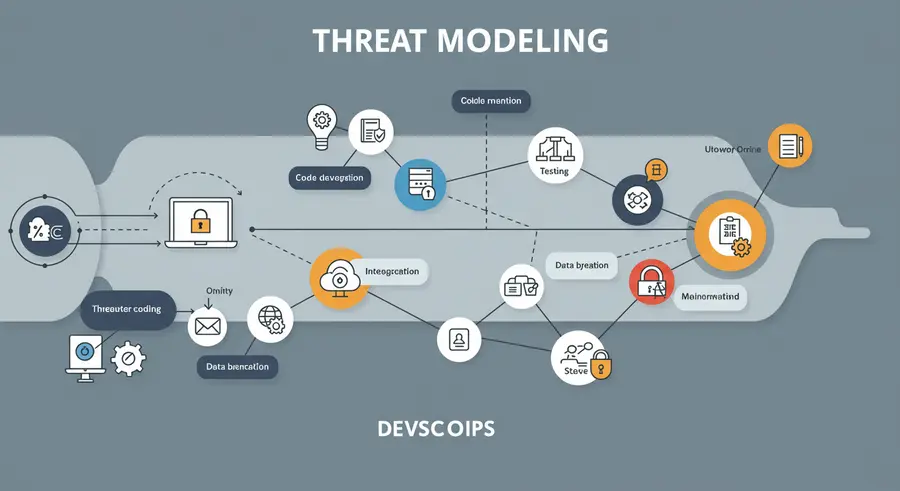Threat Modeling in DevSecOps: A Proactive Approach to Security

In the dynamic world of software development, simply reacting to security vulnerabilities after they emerge is a costly and often ineffective strategy. DevSecOps champions a shift-left approach, embedding security into every phase of the Software Development Lifecycle (SDLC). At the heart of this proactive philosophy lies threat modeling, a structured process for identifying, analyzing, and mitigating potential security threats early in the design and development phases.
Threat modeling helps teams anticipate where attacks might occur, understand their potential impact, and design appropriate countermeasures before a single line of code is written. It’s not just about finding flaws; it’s about understanding the system's security posture from an attacker's perspective, fostering a security-aware culture across development, operations, and security teams.
Why is Threat Modeling Crucial in DevSecOps?
Integrating threat modeling into your DevSecOps pipeline offers significant advantages:
- Early Detection: Identifies design flaws and architectural weaknesses that could lead to vulnerabilities, preventing them from propagating into code.
- Cost-Effectiveness: Fixing security issues during design is significantly cheaper than patching them in production.
- Improved Security Posture: Leads to a more robust and resilient application by addressing security concerns fundamentally.
- Enhanced Collaboration: Fosters communication and shared responsibility between development, security, and operations teams.
- Compliance and Governance: Helps meet regulatory requirements and internal security policies by documenting identified risks and mitigation strategies.
Common Threat Modeling Methodologies
Several methodologies can be employed for threat modeling, each with its strengths:
- STRIDE: Developed by Microsoft, STRIDE categorizes threats into Six types: Spoofing, Tampering, Repudiation, Information Disclosure, Denial of Service, and Elevation of Privilege. It's excellent for identifying common application threats.
- DREAD: Often used in conjunction with STRIDE, DREAD helps assess the risk level of identified threats based on Damage potential, Reproducibility, Exploitability, Affected users, and Discoverability.
- PASTA (Process for Attack Simulation and Threat Analysis): A seven-stage framework that considers business objectives and technical requirements to create an attack-centric view of the application.
- Trike: Focuses on a risk-based approach, ensuring that security resources are allocated effectively by mapping requirements to threat models and then to tests.
For those looking to gain a competitive edge in understanding market dynamics and making informed financial decisions, exploring advanced tools for financial analysis can be invaluable. These platforms can offer deep insights into investment opportunities, complementing a robust security strategy by protecting sensitive data and intellectual property. For instance, platforms offering AI-powered market insights can transform raw data into actionable intelligence, securing your investment future.
You can learn more about various threat modeling approaches from OWASP's Threat Modeling documentation. For practical examples of integrating security tools, Veracode offers insights into their approach. Additionally, understanding the broader landscape of cybersecurity best practices is crucial, with resources like NIST Cybersecurity Framework providing foundational guidance.
The Threat Modeling Process in DevSecOps
While methodologies vary, a typical threat modeling process in a DevSecOps context involves these key steps:
- Define Scope and Goals: Clearly delineate what system or feature is being analyzed and what security objectives are to be achieved.
- Deconstruct the Application: Understand the application's architecture, data flows, components, and trust boundaries. Data Flow Diagrams (DFDs) are particularly useful here.
- Identify Threats: Using methodologies like STRIDE, brainstorm potential threats against identified components and data flows.
- Assess Risks: Evaluate the likelihood and impact of each identified threat (e.g., using DREAD) to prioritize them based on their severity.
- Identify Mitigations: Propose and design security controls and countermeasures to address the high-priority threats. This might involve code changes, configuration adjustments, or operational procedures.
- Validate and Verify: Ensure that the proposed mitigations are effective. This often involves security testing, code reviews, and penetration testing.
Key Takeaways for Effective Threat Modeling:
- Start Early: Integrate threat modeling at the design phase.
- Collaborate: Make it a joint effort between developers, security specialists, and operations.
- Iterate: Threat models are living documents that should be revisited as the application evolves.
- Automate Where Possible: Integrate threat modeling tools into your CI/CD pipeline to automate aspects of identification and validation.
Integrating Threat Modeling into Your Workflow
For DevSecOps teams, threat modeling isn't a one-time event but an ongoing practice. It should be a regular part of sprint planning, architectural reviews, and major feature development. Tools can assist in diagramming, threat identification, and even suggesting mitigations, but human expertise and collaborative discussions remain paramount. By embedding threat modeling, organizations can significantly reduce their attack surface and build security inherently, rather than as an afterthought.